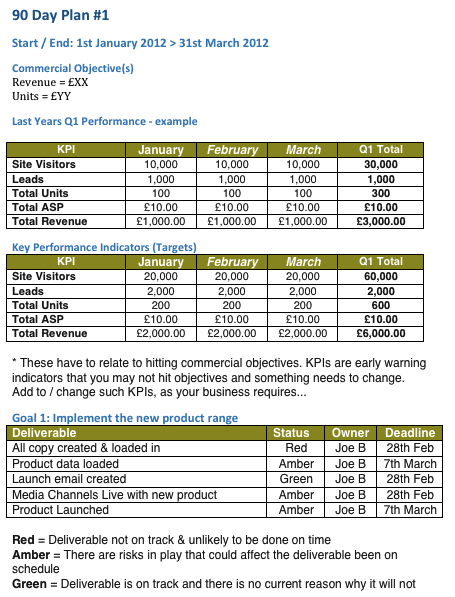A 5 step process using 90-day time-boxes to help implement your plans
The start of a new year always brings a period of reflection and forward planning. New strategies are created and exciting initiatives are launched. It's often the case though, that plans and strategies end up in drawers, little changes and businesses continue on doing the same old things.
I am lucky in that between working for both Smart Insights and First 10 I get to bridge both the creation of strategies as well as the implementation of them. At the moment I'm more involved at the implementation stage which is why I have decided to share our process for making the most of a strategy and delivering on your big ideas.
Running marketing services at First 10 often sees us managing multiple clients as well as multiple freelancers in different markets, positions etc but essentially we help clients run and manage marketing with a view of growing their business, often described as the internal, external marketing team. For our project management we use a timeboxing approach which will be familiar if you've been involved in agile/rapid applications developments. Our timeboxes here are 90 days to coincide with quarters for planning rather than shorter timeboxes for individual application or web development tasks.
For longer-term planning to ensure our timebox activities are aligned with commercial goals we use our marketing growth wheel - see infographic.
The Process
1. Create a 90 Day Focus
Plans often leave you with a lot to think about, while exciting in the opportunities they present you, it is easily overwhelming. The first part of the process is create a 90 day focus. What I mean by that is:
- Objectives for the 90 days (ideally broken down by Month)
- KPIs which help you track your objectives in - this still involves a lot of spreadsheet work, but we are increasingly using APIs and feeds to automate this (e.g. the Google Analytics API)
- Goals to ensure objectives are hit (i.e. launch product sales campaign)
- Deliverables per goal to ensure it is delivered (i.e. Paid search update, online advertising launch, E-shot update, shopping feed update, partners / affiliates brief)
90 days, to us, feels like a manageable amount of things to think about, it gives enough time to actually deliver stuff and also doesn't go on so long that you miss opportunities you need to react to.
90 Day Action Focus
The example below is from an empty template we use. As you can see a very light weight document, the idea it is to keep it simple for monthly reviews with clients and shouldn't bog you down in heavy documents.

2. Turn your Deliverables into Tasks
Once you have completed your 90 day focus document it is important each deliverable is then broken down into tasks, with assigned owners and deadlines. In common with many agencies, at First 10 & Smart Insights we utilise BaseCamp to do this. Each deliverable becomes a to-do list and tasks are loaded in. We review these more frequently with clients, typically weekly with internal reviews also.
3. Deliver the Work
Completing the tasks and if you are project managing keeping on-top of deadlines with other people involved in delivering the work is obviously crucial to delivering. Time to knuckle down... and check back with Basecamp on the latest status.
4. Create Checkpoints
At the end of each week you should check through your to-do lists and update your 90 day focus deliverables depending on the status of tasks. If tasks are overdue the status becomes amber or red (at your discretion).
Once the 90 day focus document is updated you should have a small meeting with the key stakeholders to update them on the status of deliverables and also look for solutions to any potential issues highlighted by amber & red statuses. Stick to the same date and time for checkpoint meetings, make it a habit of everyone in the team to attend and come prepared, even if some people are away still run the sessions. Communications is key to successful delivery.
At least every month you should also check against your KPIs, are you on track to hit your 90 day objectives? Do you need to update the focus due to significant changes in performance or competitor activity etc.
5. Review & Create Your Next 90 Day Focus
Ensure before starting on the next timebox that you review your 90 day focus with regards to what was delivered, what wasn't, did you hit objectives as a result of the work you have done. What did you learn that can be applied to the next 90 days? With the previous 90 days in mind and revisiting your strategy you should then set your next 90 day focus and go through the process again!
Its that easy...
We have found that by running such a simple process ensures everyone is focussed on delivering and by having a small document to discuss each week meetings become actionable and effective uses of time rather than open ended discussions. Teams are united through visibility and therefore no-one can hide behind fancy words, you are either on track or not and with the right team everyone will help each other to ensure the deliverables are met.
Do you have your own process or variation on this? Please let me know below....
Note for Expert members. You can use our 90-day marketing planning template in Word to continuously improve your approach.








